Photopolymères hybrides organique-inorganique
L'étude des nanocomposites connaît un essor considérable en chimie des polymères. Tout comme les procédés de polymérisation thermique, la photopolymérisation a connu un développement important dans ce domaine. Les matériaux organique-inorganique hybrides photopolymérisables sont généralement caractérisés par leur résistance chimique et mécanique, une dureté, une flexibilité tout en maintenant une transparence optique. La plupart des applications dans ce domaine concernent les revêtements anti-abrasifs, les films protecteurs pour plastiques ou verre et nouveaux appareillages optiques. Ce deuxième axe de recherche combine à la fois la polymérisation sol-gel et la photopolymérisation cationique ou radicalaire. L'utilisation de nanoparticules inorganiques modifiées organiquement ou la mise en place de photopolymérisation inorganique catalysée par des photoacides font partie des stratégies récemment explorées.
Photopatterning of Multilayer n-Alkylsilane Films
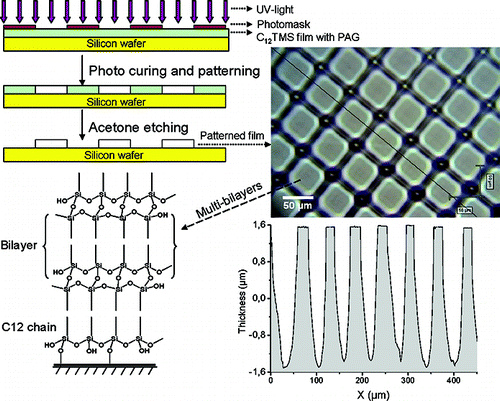
Surface photopatterning of organosilane self-assembled monolayers (SAM) has received increasing attention since its introduction 20 years ago. Herein we report for the first time a cost-efficient soft photopatterning technique affording amplified 3D multilayer structures. The essential chemistry relies on a spatially controlled photoacid-catalyzed hydrolysis and polycondensation of n-alkyltrimethoxysilane precursors (n-C12H25Si(OCH3)3,). Amphiphilic siloxane species are photogenerated locally and are able to self-assemble spontaneously into a long-range-ordered lamellar mesostructure.
Contact: Celine Croutxe-Barghorn
Source: LANGMUIR 2012 Volume: 28 Issue: 18 Pages: 7129-713
Insights into Photoinduced Sol-Gel Polymerization: An in Situ Infrared Spectroscopy Study
Photoacid-catalyzed sol-gel polymerization is now recognized as a powerful single-step synthetic approach to the synthesis of hybrid films, which can be distinguished from conventional sol-gel methods by higher reactivity and a solvent-free process. Despite its utility, the mechanism is not yet understood, in particular what chemical, physical, and photochemical parameters determine the precise sequence, kinetics, and advancement of this UV inorganic photopolymerization. Here, using mainly transmission real-time Fourier transformed infrared (RT-FTIR) spectroscopy, we characterize in situ the hydrolysis-condensation reactions of oligomeric silicon alkoxides and the formation of byproducts. Systematic review and assessment of numerous processing variables (relative humidity, film thickness, precursor structure, nature, and the concentration of photoacid generator) prove that the reaction kinetics are controlled by the two independent phenomena: the intrinsic chemical reaction rates and the water vapor permeation into the film.
Contact: Celine Croutxe-Barghorn
Source: JOURNAL OF PHYSICAL CHEMISTRY B Volume: 116 Issue: 17 Pages: 5260-5268
A solvent-free photochemical route for the preparation of mesoporous inorganic films
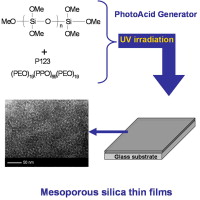
An alternative to the Evaporation Induced Self Assembly (EISA) method is described as a fast and simplified approach towards mesoporous silica films. The sol–gel process is photochemically triggered with the aid of photoacid generator (PAG), thereby making mesostructuration independent offilmdeposition conditions, solvent evaporation and complex chemistry associated with a silica sol. Thedeveloped solvent-free synthesis uses non-ionic poly(ethylene oxide)-based surfactants and polydimethoxysiloxane, affording after UV irradiation afilm with a wormhole porous framework, and auniform pore size distribution. The disordered mesostructure was characterized by X-ray diffraction, N2adsorption, 29Si solid-state NMR and transmission electron microscopy.
Contact: Celine Croutxe-Barghorn Source: MICROPOROUS AND MESOPOROUS MATERIALS , 2012, Volume: 151 Pages: 88-92
Photoinduced synthesis and ordering of lamellar n-alkylsiloxane films
 Self-assembled organosilica films exhibiting various lamellar structures were prepared withoutsolvent and water via the fast photoacid-catalyzed sol–gel process of n-alkyltrimethoxysilanes (CnTMS, n = 8, 10, 12, 16 and 18). This facile photochemical route towards nanostructured hybrid films relies on superacid photocatalyst generated by the UV photolysis of a soluble lipophilic iodonium salt: (C12H25)2Φ2I+ SbF6−. A main emphasis has been on discussing the effect of the alkyl chain length on the level of ordering of the layered mesostructure (short- or long-range order), the alkyl chain packing arrangement (bilayered or interdigitated) and its conformational order (gauche and trans). X-Ray diffraction and electron microscopy (TEM andSEM) proved the high periodicity achieved with the long chain alkylsilanes (n = 16 and 18). Real-time Fourier transform infrared spectroscopy (RT-FTIR) was also instrumental in giving a unique insight into the sol–gel reaction kinetics and the progressive conformational ordering of the alkyl chains during the photoinduced self-assembly. Further, the combination of differentsolid-state NMR techniques (29Si and 13C) shed light on the siloxy layer microstructure and the conformational structure of the alkyl chain respectively.
Self-assembled organosilica films exhibiting various lamellar structures were prepared withoutsolvent and water via the fast photoacid-catalyzed sol–gel process of n-alkyltrimethoxysilanes (CnTMS, n = 8, 10, 12, 16 and 18). This facile photochemical route towards nanostructured hybrid films relies on superacid photocatalyst generated by the UV photolysis of a soluble lipophilic iodonium salt: (C12H25)2Φ2I+ SbF6−. A main emphasis has been on discussing the effect of the alkyl chain length on the level of ordering of the layered mesostructure (short- or long-range order), the alkyl chain packing arrangement (bilayered or interdigitated) and its conformational order (gauche and trans). X-Ray diffraction and electron microscopy (TEM andSEM) proved the high periodicity achieved with the long chain alkylsilanes (n = 16 and 18). Real-time Fourier transform infrared spectroscopy (RT-FTIR) was also instrumental in giving a unique insight into the sol–gel reaction kinetics and the progressive conformational ordering of the alkyl chains during the photoinduced self-assembly. Further, the combination of differentsolid-state NMR techniques (29Si and 13C) shed light on the siloxy layer microstructure and the conformational structure of the alkyl chain respectively.
Contact: Celine Croutxe-Barghorn
Source: JOURNAL OF MATERIALS CHEMISTRY, 2012, Volume: 22 Issue: 2 Pages: 643-652
Simultaneous sol-gel and anionic photopolymerization of 3-(glycidyloxypropyl)trimethoxysilane via photobase catalysis
.gif) Type II polyether–silica hybrid films were successfully synthesized from 3-(glycidyloxypropyl)trimethoxysilane (GPTMS) through a novel photobase-catalyzed sol–gel andanionic polymerization using an α-amino acetophenone derivative as a tertiary aminephotogenerator. We report here some characterization evidence establishing that the hybrid precursor undergoes two different polymerization reactions in a single step. FTIR analysis as well as solid-state NMR (13C, 29Si) shed light onto the tandem formation of the silica network and the polyether chains. The prominent role played by α-amino acetophenone in the dual catalysis was also highlighted by comparison with other O-acyloxime-based photobase generators.
Type II polyether–silica hybrid films were successfully synthesized from 3-(glycidyloxypropyl)trimethoxysilane (GPTMS) through a novel photobase-catalyzed sol–gel andanionic polymerization using an α-amino acetophenone derivative as a tertiary aminephotogenerator. We report here some characterization evidence establishing that the hybrid precursor undergoes two different polymerization reactions in a single step. FTIR analysis as well as solid-state NMR (13C, 29Si) shed light onto the tandem formation of the silica network and the polyether chains. The prominent role played by α-amino acetophenone in the dual catalysis was also highlighted by comparison with other O-acyloxime-based photobase generators.
Contact: Celine Croutxe-Barghorn
Source: NEW JOURNAL OF CHEMISTRY, 2011, Volume: 35 Issue: 9 Pages: 1803-1808
Self-Organized Poly(n-octadecylsilsesquioxane) Films via Sol-Gel Photopolymerization
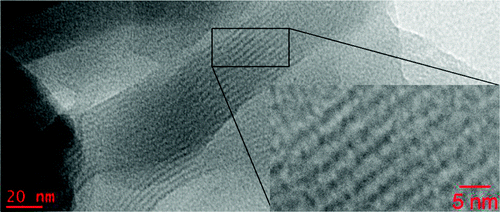 We describe a novel solvent- and water-free sol–gel process for n-octadecyltriclorosilane (C18H37SiCl3) film catalyzed by photogenerated brönsted acids. Driven by hydrophobic van der Waals interactions, a photoinduced self-assembly process occurs to afford a long-range ordered lamellar mesostructure, characterized by X-ray diffraction and transmission electron microscopy. Real-time Fourier transform IR spectroscopy was instrumental to probe the fast hydrolysis kinetics and assess the change of conformational behavior of the alkyl chains during UV irradiation. A unique combination of different solid-state NMR techniques (29Si,13C, 1H) provided an insight into the supramolecular organization of this hybrid film
We describe a novel solvent- and water-free sol–gel process for n-octadecyltriclorosilane (C18H37SiCl3) film catalyzed by photogenerated brönsted acids. Driven by hydrophobic van der Waals interactions, a photoinduced self-assembly process occurs to afford a long-range ordered lamellar mesostructure, characterized by X-ray diffraction and transmission electron microscopy. Real-time Fourier transform IR spectroscopy was instrumental to probe the fast hydrolysis kinetics and assess the change of conformational behavior of the alkyl chains during UV irradiation. A unique combination of different solid-state NMR techniques (29Si,13C, 1H) provided an insight into the supramolecular organization of this hybrid film
Contact: Celine Croutxe-Barghorn
Source: LANGMUIR, 2011, Volume: 27 Issue: 20 Pages: 12621-12629
Tandem Cationic and Sol-Gel Photopolymerizations of a Vinyl Ether Alkoxysilane
In the present study, a novel single hybrid monomer combining a vinylether and trimethoxysilane groups in the same molecule was synthesized by chemoselective hydrosilation and subjected to UV-irradiation in the presence of a triarylsulfonium salt. Through the UV-decomposition of this photoacid generator, two acid-catalyzed processes occurred simultaneously: the cationic polymerization of the vinyl ether functions and the sol–gel polycondensation of the alkoxysilyl groups, leading to a type II polyvinyl-polysilicate nanocomposite film. Both reaction kinetics were efficiently monitored by real-time Fourier transform infrared spectroscopy, and the influence of different key experimental parameters was investigated (laminated conditions, UV irradiation equipment, and film thickness). A particular attention was also given to the complete characterization of the hybrid microstructure by associating 29Si and 13C solid-state NMR.
Contact: Celine Croutxe-Barghorn
Source: POLYMER ENGINEERING AND SCIENCE, 2011 Volume: 51 Issue: 8 Special Issue: SI Pages: 1466-1475
A Simple Method for the Reinforcement of UV-Cured Coatings via Sol-Gel Photopolymerization
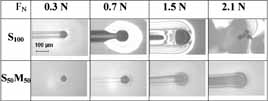 A difunctional methacrylate oligomer was mixed with a variable amount of a MAPTMS precursor in the presence of both a radical and a cationic photoinitiator. The simultaneous photolysis of both photosensitive molecules upon UV irradiation allowed the single-step generation of a type-II polymethacrylate/polysiloxane nanocomposite film. Methacrylate and methoxysilyl conversions during irradiation were efficiently monitored by FTIR spectroscopy. The inorganic structure of the resulting silica-based hybrid films was characterized using 29Si solid-state NMR. Finally, the reinforcement ability of the resulting hybrid films was also assessed by using a unique range of characterization techniques: DMA, scratch test, and nanoindentation.
A difunctional methacrylate oligomer was mixed with a variable amount of a MAPTMS precursor in the presence of both a radical and a cationic photoinitiator. The simultaneous photolysis of both photosensitive molecules upon UV irradiation allowed the single-step generation of a type-II polymethacrylate/polysiloxane nanocomposite film. Methacrylate and methoxysilyl conversions during irradiation were efficiently monitored by FTIR spectroscopy. The inorganic structure of the resulting silica-based hybrid films was characterized using 29Si solid-state NMR. Finally, the reinforcement ability of the resulting hybrid films was also assessed by using a unique range of characterization techniques: DMA, scratch test, and nanoindentation.
Contact: Celine Croutxe-Barghorn
Source: MACROMOLECULAR MATERIALS AND ENGINEERING, 2011, Volume: 296 Issue: 6 Pages: 506-516
Friction and wear properties of hybrid sol-gel nanocomposite coatings against steel: Influence of their intrinsic properties
A dual UV-curing process inducing in a single step cationic photopolymerization and a photoinduced sol-gel process was used to obtain novel hybrid coatings. For this, an epoxy resin based on hydrogenated diglycidyl ether bisphenol A was mixed with an epoxy trimethoxysilane precursor (GPTMS, TRIMO) in the presence of photoacid generator based on diaryliodonium salt. Various UV-cured coatings were prepared with different amounts of the hybrid monomer (2 and 5 wt%), and two thicknesses: 15 and 8μm. The friction and wear properties of these coatings were characterized on a ball-on-disc tribometer (steel ball; applied normal load: 6N; sliding speed: 5cm/s). Both.
Contact: Celine Croutxe-Barghorn
Source: APPLIED SURFACE SCIENCE, 2011, Volume: 257 Issue: 15 Pages: 6618-6625
Combination of Radical and Cationic Photoprocesses for the Single-Step Synthesis of Organic-Inorganic Hybrid Films
Nanocomposite materials prepared from radically photocurable hybrid sol―gel precursors have been widely developed within the last decade, especially to devise novel optical devices and coatings. For their synthesis, a preferential route has involved in the successive sol―gel process of acrylate trialkoxysilane precursors followed by radical photopolymerization. In contrast, this work presents an original one-step synthesis based on the association of two different photoinitiators (Pls) in the same formulation: the photolysis of a hydroxyphenylketone (radical PI) affords polyacrylate chains while that of a diaryl iodonium salt (cationic PI) generates powerful superacids catalyzing the sol-gel reactions of the alkoxy functions. The behavior of methacrylate and acrylate trimethoxysilane precursors was compared to highlight the effect of the organic moiety functionality on the reaction kinetics (Fourier transform infrared spectroscopy) and the film microstructure (13C and 29Si solid-state nuclear magnetic resonance). Interestingly, evidence of local organization in these hybrid films was also given by X-ray analysis. In a last part, their thermomechanical properties were discussed thoroughly using a range of techniques: DSC, scratch-resistance test, nanoindentation.
Contact: Celine Croutxe-Barghorn
Source: JOURNAL OF POLYMER SCIENCE PART A-POLYMER CHEMISTRY, 2010, Volume: 48 Issue: 19 Pages: 4150-4158
Combination of radical and cationic photoprocesses for the single-step synthesis of organic-inorganic hybrid films
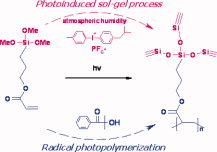
In this work, the dual organic-–inorganic UV-curing of (meth)acrylate trimethoxysilane precursors is performed in one step through the association of a radical and a cationic photoinitiator. The interdependency between the acrylate polymerization and the photoinduced sol-–gel process is kinetically investigated by FTIR. In addition to the nano-organization study with X-ray diffraction, the mechanical property profiles of the resulting hybrid films are characterized upon combining scratch resistance and nanoindentation analysis.
Contact: Celine Croutxe-Barghorn
Representative publication: Journal of Polymer Science Part A: Polymer Chemistry Volume 48, Issue 19, pages 4150–4158, 1 October 2010
bridged polysilsesquioxane films via photoinduced sol–gel chemistry
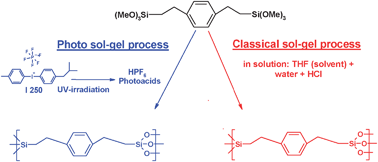
The synthesis and characterization of bridged polysilsesquioxane films was performed via a photoacid-catalyzed sol–gel method using a series of three precursors with different organic moiety structures.
Contact: Celine Croutxe-Barghorn
Representative publication: New J. Chem., 2010, (6),1068-1072
Synthesis of Organosilica Films Through Consecutive Sol/Gel Process and Cationic Photopolymerization

The cationic photopolymerization of epoxy polysilsesquioxane resins synthesized through a acid-catalyzed sol/gel process is studied. To elucidate the effect of the organic substituent on sol/gel reaction kinetics, two organotrimethoxysilanes with different organic groups were employed. Effects of UV irradiation on the microstructure of the epoxy-functional polysilsesquioxanes were also studied. 29Si solid-state MAS NMR proved that UV-generated brönsted acids favored a work-up of the silicate network by promoting new sol/gel condensation reactions. There was a significant slowdown of epoxy conversion rates with increasing sol aging, which may be due to a competition between an active chain end and an activated monomer mechanism for the epoxy cationic polymerization.
Contact: Celine Croutxe-Barghorn
Representative publication: Macromolecular Materials and Engineering Volume 295, Issue 4, April 14, 2010, Pages: 355–365
Nanocomposite Coatings via Simultaneous Organic-Inorganic Photoinduced Polymerization: Synthesis, Structural Investigation and Mechanical Characterization
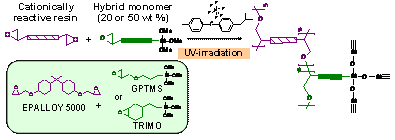 Hybrid sol-gel films were prepared via a simultaneous organic-inorganic UV-curing process using a diaryl iodonium salt as a superacids' photogenerator. In this single-step procedure, an epoxy functional reactive resin (EPALLOY 5000) mixed with a variable amount of epoxy trialkoxysilane precursor (TRIMO or GPTMS) was UV-irradiated, causing both the initiation of epoxy ring-opening copolymerization and the catalysis of trialkoxysilyl sol-gel reactions. The concomitant photoinduced sol-gel process was found to have a significant effect on the two related propagation mechanisms in competition for the oxirane ring-opening: the active chain end and the activated monomer mechanisms, as proved by a systematic examination of the hybrid material microstructure through 29Si and 13C solid state NMR spectroscopy. The effect of the oxo-silica network generation on the epoxy reaction kinetics was also evaluated by RT-FTIR upon varying the epoxysilane structure and its concentration. Thermal and dynamic mechanical analyses were systematically performed on these hybrids, by studying thoroughly their structure-property interdependence. Other mechanical characterizations through tribological and scratch tests suggest that the present photopolymer/silica hybrid material provides a powerful tool to tailor mechanical property profiles.
Hybrid sol-gel films were prepared via a simultaneous organic-inorganic UV-curing process using a diaryl iodonium salt as a superacids' photogenerator. In this single-step procedure, an epoxy functional reactive resin (EPALLOY 5000) mixed with a variable amount of epoxy trialkoxysilane precursor (TRIMO or GPTMS) was UV-irradiated, causing both the initiation of epoxy ring-opening copolymerization and the catalysis of trialkoxysilyl sol-gel reactions. The concomitant photoinduced sol-gel process was found to have a significant effect on the two related propagation mechanisms in competition for the oxirane ring-opening: the active chain end and the activated monomer mechanisms, as proved by a systematic examination of the hybrid material microstructure through 29Si and 13C solid state NMR spectroscopy. The effect of the oxo-silica network generation on the epoxy reaction kinetics was also evaluated by RT-FTIR upon varying the epoxysilane structure and its concentration. Thermal and dynamic mechanical analyses were systematically performed on these hybrids, by studying thoroughly their structure-property interdependence. Other mechanical characterizations through tribological and scratch tests suggest that the present photopolymer/silica hybrid material provides a powerful tool to tailor mechanical property profiles.
Contact: Celine Croutxe-Barghorn
Representative publication : Polym. Int. 2010, 59 (8) 1175-1186
Nanocomposite coatings via simultaneous organic-inorganic photo-induced polymerization: synthesis, structural investigation and mechanical characterization
Hybrid sol-gel films were prepared via a simultaneous organic-inorganic UV-curing process using a diaryliodonium salt as a superacid photogenerator. In this single-step procedure, an epoxy functionalized reactive resin mixed with a variable amount of either of two epoxy trialkoxysilane precursors was UV-irradiated, causing both the initiation of epoxy ring-opening copolymerization and the catalysis of trialkoxysilyl sol-gel reactions. The concomitant photo-induced sol-gel process was found to have a significant effect on the two related propagation mechanisms in competition for the oxirane ring-opening - the active chain-end and the activated monomer mechanisms-as proved by a systematic examination of the hybrid material microstructure through 29Si and 13C solid-state NMR spectroscopy. The effect of the oxo-silica network generation on the epoxy reaction kinetics was also evaluated using real-time Fourier transform infrared spectroscopy upon varying the epoxysilane structure and its concentration. Thermal and dynamic mechanical analyses were systematically performed on these hybrids, by studying thoroughly their structure-property interdependence. Other mechanical characterizations through tribological and scratch tests suggested that the present photopolymer-silica hybrid material provides a powerful tool to tailor mechanical property profiles.
Contact: Celine Croutxe-Barghorn
Source: POLYMER INTERNATIONAL, 2010 Volume: 59 Issue: 8 Pages: 1175-1186
Concomitant Organic-Inorganic UV-Curing Catalyzed by Photoacids
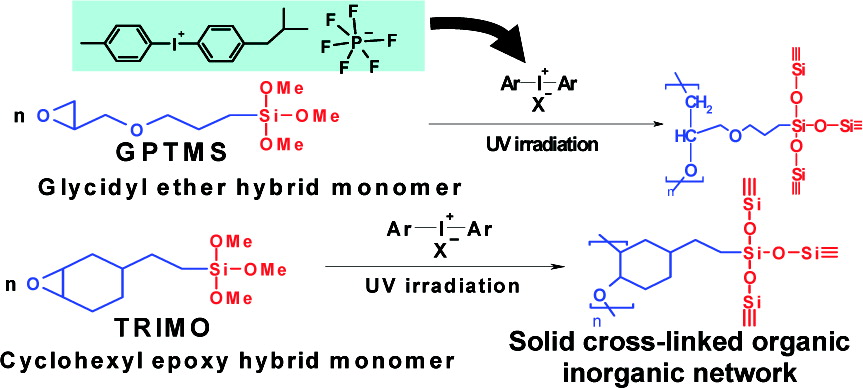
In this work, a novel one-step methodology for preparing hybrid sol-gel coatings has been investigated by UV irradiation of simple and commercial bifunctional hybrid precursors R'Si(OR)3, bearing both an organic epoxy function and alkoxysilane moieties, in presence of an aryl iodonium salt catalyst. Through the in situ liberation of protic acids via onium salt photolysis, polymerization of epoxy takes place concomitantly with hydrolysis and condensation of the reactive silanes. This straightforward method gives access to a stable, solvent-free and single-component hybrid coating composition, which can be applied at room temperature and cured upon UV exposure. For an effective initiation of the sol-gel process, the presence of a catalytic amount of moisture has been found to be necessary. While oxirane is a classical cationically photopolymerizable function, it is not the case of hydrolyzable alkoxysilyl groups. Very few studies addressing sol-gel process catalyzed by photoinduced protic acids have been indeed reported in the literature.
Contact: Celine Croutxe-Barghorn
Representative publication: Macromolecules, 2008, 41 (20), pp 7390–7398
